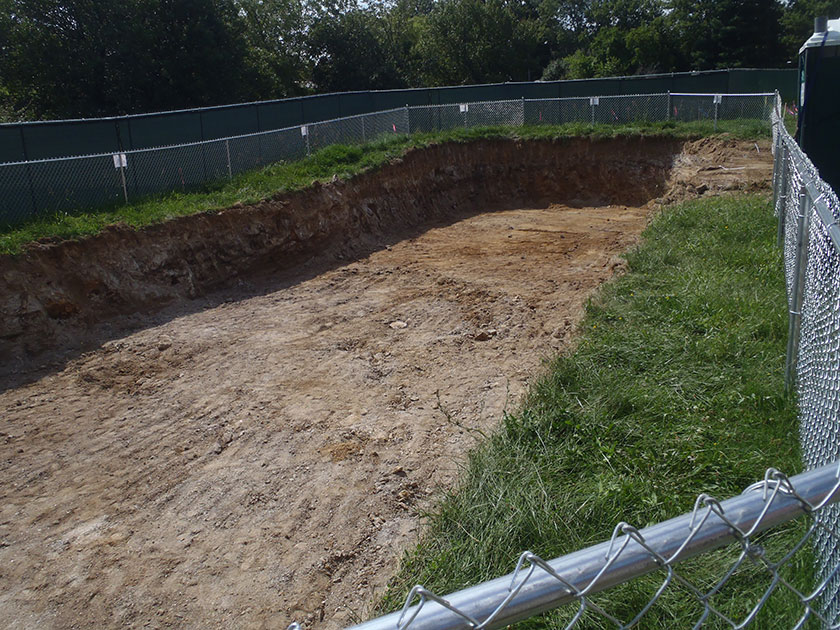An understanding of common construction issues associated with Erosion and Sediment Control (E&S) measures and stormwater management practices (SMPs) is an important component of effective construction inspections and can help to minimize or avoid these issues. Avoiding these issues streamlines regulatory approval, minimizes negative impacts to the surrounding environment, promotes long-term SMP function, and reduces the cost and duration of construction activities.
5.2.1 Erosion and Sediment-Related Construction Issues
Proper E&S measures are required to keep sediment and pollutants out of existing and proposed sewer systems and, ultimately, Philadelphia’s waterways. The goals of E&S measures are to minimize the amount of erosion that takes place and to keep all sediment accumulation within the earth disturbance boundary. E&S measures are also critical to the protection of existing on-site infrastructure and to reducing the risk of downstream impacts like sediment blockages. Approved E&S measures must be installed and inspected prior to the start of any earth disturbance activities. These E&S measures must be maintained and functional throughout the duration of construction, until the site has been stabilized.
Protection of City-Owned Inlets
Any city-owned inlets that receive stormwater runoff from the construction site must be protected. Contractors need to pay special attention to inlets located at the lowest points, as these will likely receive the most sediment and need to be maintained the most frequently. City-owned inlet protection should not be the primary means of E&S, but an important safeguard to supplement keeping sediment on-site through continuous E&S maintenance, including prevention of sediment tracking off-site.
Additional Erosion and Sediment Issues
Silt fencing must be properly trenched into the ground and backfilled to properly control sediment run-off from any disturbed areas. E&S controls must also be placed around SMP elements to prevent sediment loading from any surrounding unstabilized, disturbed areas. Also, in order to prevent SMP clogging and off-site impacts, all SMP inlets and other on-site inlets must be protected for the full duration of construction activities and until the site has achieved final stabilization. Bioinfiltration/bioretention basins and subsurface infiltration basins may be used as sedimentation basins during construction. The contractor is referred to Section 4.1 and Section 4.4, respectively, for requirements for the use of these SMPs as temporary sediment basins.
5.2.2 Stormwater Management Practice-Related Construction Issues
Compaction or sedimentation within infiltration areas and the use of stone containing fines are among the most common construction issues that can affect the infiltration capacity, and thus the performance and suitability, of an SMP.
Protection of Infiltration Areas
Protection of infiltration areas is important because, with the exception of SMPs designed to function as disconnected impervious cover (DIC), infiltration SMPs are designed based on testing that is performed on undisturbed soils prior to installation. Compaction of these areas could change infiltration rates and cause the SMP to underperform, leading to the need for redesign and/or reconstruction of the SMP. For these reasons, soil compaction should be minimized, even in areas not proposed for infiltration SMPs, to the extent practicable. The best strategy to avoid compaction is to simply avoid equipment traffic within proposed infiltration areas, before, during, and after SMP construction. Where construction equipment traffic is necessary, timber matting or low pressure equipment must be used.
If compaction of infiltration areas is required due to site constraints, the contractor must scarify the ground surface to minimum depths of eight inches for minor compaction and 12 inches for major compaction within the infiltration footprint prior to SMP installation.
Requirements for Protecting Infiltration Areas
- Do not use heavy equipment such as excavators, loaders, or dump trucks within the infiltration area, before or after excavation.
- Establish heavy equipment exclusion zones so that infiltration areas are clearly protected.
- Install orange construction fence or silt fence around the exclusion zones.
- Keep equipment out of the infiltration area to the maximum extent possible.
- Consider equipment limitations and maneuverability during design to facilitate operation of equipment outside the infiltration area.
- Do not locate rock construction entrances on top of areas proposed for infiltration practices.

Use of Clean Stone
Clean-washed stone must be used where indicated by SMP designs. Clean-washed stone must not only be delivered to the site in a clean state, but also stored, moved, and installed in a manner that does not introduce fines. Failure to install appropriately clean stone could impact infiltration performance and require redesign and/or reconstruction. The PWD Inspector may test a sample of stone at any time it is suspected of not meeting required standards. Stone will be tested using the AASHTO T-11 wash loss test and must have less than 0.5% wash loss.
Pipe Loading
Sufficient temporary cover of piping must be provided during all stages of construction, and heavy loads on these pipes must be avoided. Heavy loads can cause separation or damage to the pipe system that, while not necessarily readily apparent, could lead to long-term functionality and maintenance concerns. Any stone placed on top of piping must be placed gently (i.e., not dumped) to avoid these issues.
Inspection and Documentation
The contractor must ensure that all subsurface SMP elements have been inspected by PWD and fully documented (survey data, photos, etc.) prior to backfilling these areas to prevent corrective actions that could include re-excavation to affirm correct installation practices.